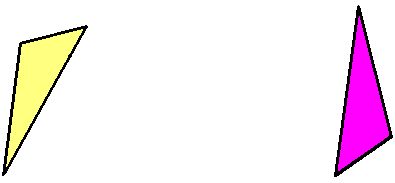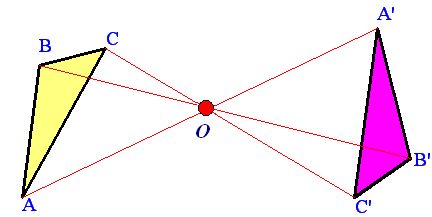SUMMARY.
It is advisable for you to solve these exercises and questions in order to clarify and consolidate all the concepts seen in this course. We have included answers and solutions in case you find them difficult.
8.20 We have points A and B in a line. Are they symmetrical?
Answer: No, they would be symmetrical in respect to a point, a line,...
8.21 In order for the points in the previous exercise to be symmetrical to point O, should this point be in the middle of points A and B?
Answer: Yes
8.22 Are these shapes symmetrical? If so, what type of symmetry do they have? why?

Answers: They are symmetrical. They have a central symmetry in respect to O (next image). A rotation in O produces a correspondence in points.

Point O is the middle point where the lines that join the counterpart points meet.
8.23 Can a line be an axis of symmetry?
Answer: Yes
Solution:
The line will be the bisector since it is located at an equal distance from all counterpart points.
You can test this in the following image:
8.24 Homothety is: ... a rotation..., ... an enhancement, ... a translation, ... a transformation, …..of a shape in a plane?
Answer: Homothety is a geometrical transformation of a body (shape) which is produced from a point and increases the measurements of that shape. Such increase in measurements is originated by the same factor.
Starting from point O, the second A has the same measurements as the smaller A times the factor 3. The small A has transformed into the larger A .
8.25 Are similar shapes homothetic? Why?
Answers: Similar shapes are homothetic shapes and vice-versa.
Similar shapes have the same shape or form but their sizes are different. Homothetic shapes are shapes which have been transformed because all of their measurements have been altered (enlarged) because of a factor in relation to the original shape.
8.26 Can a homothetic shape be smaller than the original? When?
Answers: Yes, it can be smaller when the factor is less than 1.
8.27 Can we state that a homothetic shape is a reduced or enlarged version of the original?
Answer: Yes.
8.29 Is it true that two shapes are similar if they have different areas but the same form?
Answer: Yes.
8.30 Can the sides of two homothetic shapes not be parallel?
Answer: No.